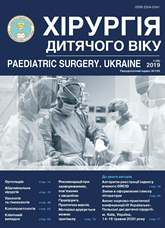The case of application of the retrained operational up-stupe to the tumor located on the borning- interior surface of the top third diaphism of the big-tonal bone
DOI:
https://doi.org/10.15574/PS.2019.65.67Keywords:
operative access, tumor, tibia, diaphysis, upper third, posterior-outer surfaceAbstract
For citation: Shchokin OV, Spakhi OV. (2019). The case of application of the retrained operational up-stupe to the tumor located on the borning-interior surface of the top third diaphism of the big-tonal bone. Paediatric Surgery.Ukraine. 4(65): 67-71. doi 10.15574/PS.2019.65.67Article received: Jul 11, 2019. Accepted for publication: Dec 18, 2019.
Objective. To develop low-traumatic and safe operative access to the posterior surface of the tibial diaphysis in the upper third and acquaint the operating orthopedic trauma surgeons, oncologists and surgeons with it.
Materials and methods. According to the scientific literature, the study and analysis of the topography of anatomical formations of this area were conducted with respect to possible options for access to the posterior external surface of the upper third of the tibial diaphysis. Anterior, anterior and anterior internal accesses were studied. These accesses are offered by most authors in the scientific literature. Along with these approaches, many authors propose to use the posterior and posterior-external accesses, which are located closest to the posterior outside surface of the tibial diaphysis in the upper third. All these approaches are either too traumatic, or with their help it is almost impossible to reach the posterior surface of the tibial diaphysis in the upper third. The least traumatic and safest is a backward access. It is carried out as follows. An incision of the skin triad is performed, retreating 1 centimeter posterior to the posterior inner edge of the tibia and parallel to it. Medial edges of the gastrocnemius and soleus muscles are stupidly and acutely exfoliated. After removal of the muscles posteriorly, the posterior tibial and peroneal vessels and tibial nerve open, which are retracted along with the muscles. After separation of the posterior tibial muscle, access to the upper third of the diaphysis of the inner surface of the tibial bone is opened without damaging the important anatomical structures.
Clinical case. A 16-year-old child with two tumors (osteochondromas) located on the inner and posterior surface of the tibial bone in the upper third of the diaphysis from the posterior-internal access was operated on in the clinic. Anatomical structures and structures were not damaged. This confirmed the security of the back door.
Conclusion. The case of posterior-internal access, which was carried out to remove a tumor located on the posterior surface of the tibial bone in its upper third, showed that this access is less traumatic and safe.
The research was carried out in accordance with the principles of the Helsinki Declaration. The study protocol was approved by the institution’s Local Ethics Committee. The informed consent of the child and his parents was obtained from the studies.
References
a1. Bojchev B, Komforti V, Chokanov K. (1961). Operativnaja ortopedija i travmatologija. Sofija: Medicina i fizkul’tura: 834.
Ivanova VD, Kolsonov AV, Mironov AA, Jaremin BI. (2007). Amputacii. Operacii na kostjah i sustavah. Samara: 176.
Kovanov VV, Travin AA. (1983). Hirurgicheskaja anatomija konechnostej cheloveka. Moscow: Medicina: 494.
Movshovich IA. (1994). Operativnaja ortopedija. Rukovodstvo dlja vrachej. Moscow: Medicina: 448.
Pat. na korisnu model’ No. 131212, Ukraїna, MPK A618 17/00. Sposіb operativnogo dostupu do zadn’olateral’noї poverhnі verhn’oї tretini dіafіzu velikogomіlkovoї kіstki. O.V. Shhokіn; vlasniki: Zaporіz’kij derzhavnij medichnij unіversitet, O.V. Shhokіn. – u201807053; zajavl. 23.06.2018; opubl. 10.01.2019; Bjul. No. 1/2019.
Revenko TA, Gur’ev VN, Shesternja NA. (1987). Atlas operacij pri travmah oporno-dvigatel’nogo apparata. Moscov: Medicina: 272.
Shchekin OV. (2013). Method of surgical reconstruction of pelvic ring continuity in children with extrophy of bladder. Pathologia.1(27): 95-96.
Issue
Section
License
The policy of the Journal “PAEDIATRIC SURGERY. UKRAINE” is compatible with the vast majority of funders' of open access and self-archiving policies. The journal provides immediate open access route being convinced that everyone – not only scientists - can benefit from research results, and publishes articles exclusively under open access distribution, with a Creative Commons Attribution-Noncommercial 4.0 international license(СС BY-NC).
Authors transfer the copyright to the Journal “PAEDIATRIC SURGERY.UKRAINE” when the manuscript is accepted for publication. Authors declare that this manuscript has not been published nor is under simultaneous consideration for publication elsewhere. After publication, the articles become freely available on-line to the public.
Readers have the right to use, distribute, and reproduce articles in any medium, provided the articles and the journal are properly cited.
The use of published materials for commercial purposes is strongly prohibited.

